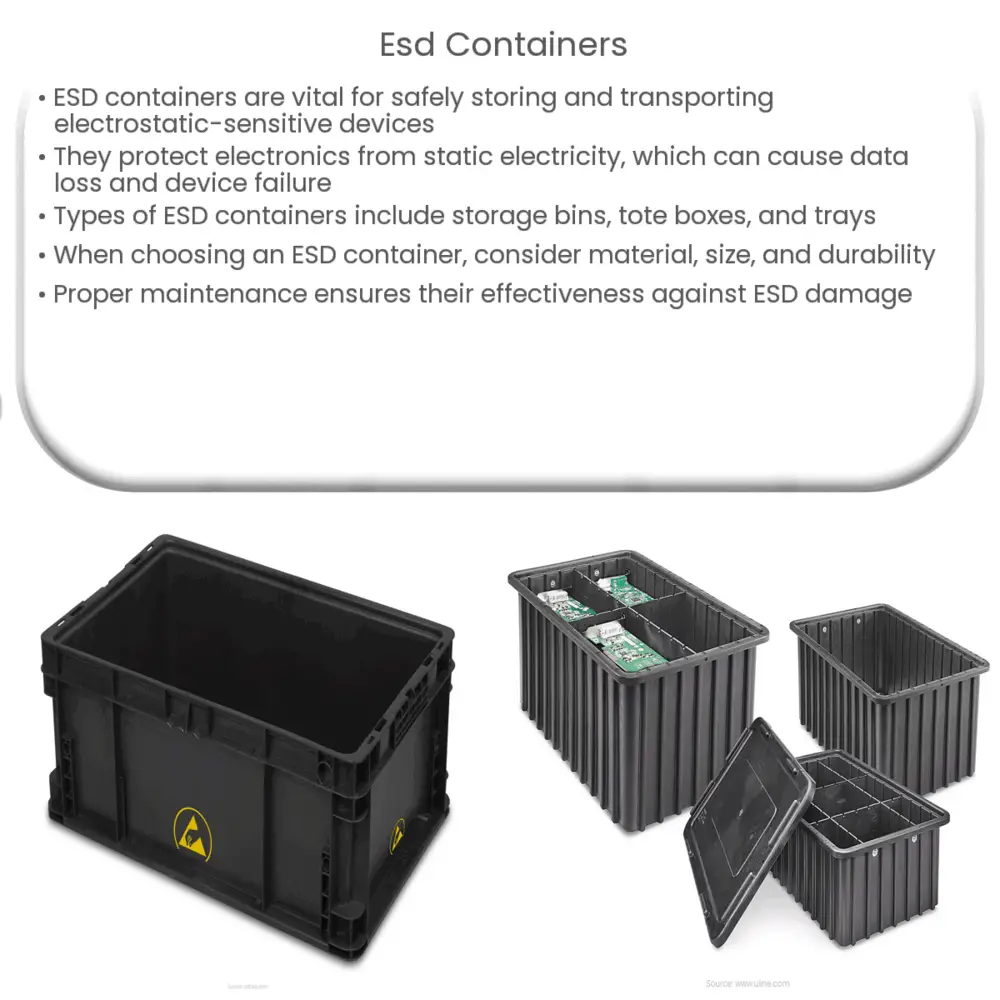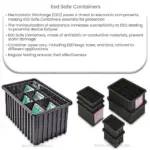Explore the crucial role of ESD containers in safeguarding sensitive electronics from static damage, their types, maintenance, and industry standards.

Understanding ESD Containers
Electrostatic Discharge (ESD) containers are a critical component in the safe storage and transport of electrostatic-sensitive devices. ESD can cause severe damage to electronic components, and thus, to mitigate the risk, specialized containers are utilized.
The Role of ESD Containers
ESD containers are designed to protect electronic components from static electricity. Static electricity is an imbalance of electric charges within or on the surface of a material. The charge remains until it can move away via an electric current or electrical discharge. When this static electricity is discharged, it can generate an ESD event. ESD can cause a range of harmful effects, from data loss to physical damage that leads to the entire device failing.
ESD containers are made of materials that help dissipate static electricity, thus providing protection to sensitive electronics. They play an essential role in preventing static damage during storage and transportation of electronic devices.
Types of ESD Containers
- ESD Storage Bins: These are primarily used in warehouses or factories for storing large quantities of ESD-sensitive items. They are designed to be sturdy and long-lasting.
- ESD Tote Boxes: These are small, portable containers used for storing and transporting individual electronic components. They are typically constructed from conductive polypropylene.
- ESD Trays: Trays provide a convenient method for organizing and transporting smaller, sensitive electronic components.
Selection of ESD Containers
When selecting an ESD container, several factors need to be considered. The container’s material should be a primary consideration, ensuring it offers the necessary ESD protection. Further, the size of the container should suit the size of the components to be stored. Finally, the container’s durability is critical, as it needs to withstand the rigors of storage and transportation.
Understanding the significance of ESD containers and their role in preserving sensitive electronic devices from static electricity damage can significantly benefit both individuals and companies involved in the handling, storage, and transportation of these components. They provide a first line of defense against ESD and are an integral part of a comprehensive ESD control program.
Manufacturing ESD Containers
ESD containers are typically manufactured from conductive or dissipative polymers, such as polypropylene or high-density polyethylene, which help to neutralize static charges. The manufacturing process involves various stages, including polymer selection, shaping, and testing for ESD protection.
Maintaining ESD Containers
Maintaining ESD containers is essential for their continued effectiveness. Regular cleaning is recommended, but it should be done carefully to avoid damage to the ESD protective properties. Use of harsh chemicals or abrasive materials can degrade the container’s ability to dissipate static charges and should be avoided. Periodic testing of containers for their resistance to ESD is also an integral part of maintenance.
Regulatory Standards for ESD Containers
Several regulatory standards guide the production and use of ESD containers. These include the ANSI/ESD S20.20 standard, which provides comprehensive administrative and technical requirements for an ESD control program. Adherence to these standards ensures the effectiveness of ESD containers and helps maintain the integrity of the electronic components they protect.
Benefits of ESD Containers
ESD containers offer several benefits, including improved lifespan and reliability of electronic components, reduced repair and replacement costs, and increased efficiency in manufacturing processes. They are crucial in industries like electronics manufacturing, telecommunications, aviation, and more, where ESD damage can lead to significant financial loss and potential safety risks.
Conclusion
In conclusion, ESD containers are an indispensable tool in the storage and transportation of electronic components. Their capacity to neutralize static electricity provides vital protection for sensitive devices, ensuring their longevity and reliability. Whether it’s a large-scale manufacturing setup or a small electronics repair workshop, ESD containers are a necessity in preventing costly ESD damage. Recognizing their importance and adhering to recommended usage and maintenance guidelines can significantly improve the efficiency and cost-effectiveness of handling electronic components. As technology continues to evolve and become increasingly integrated into our daily lives, the role of ESD containers is expected to become even more significant.



